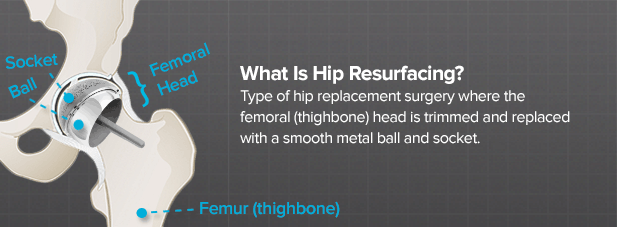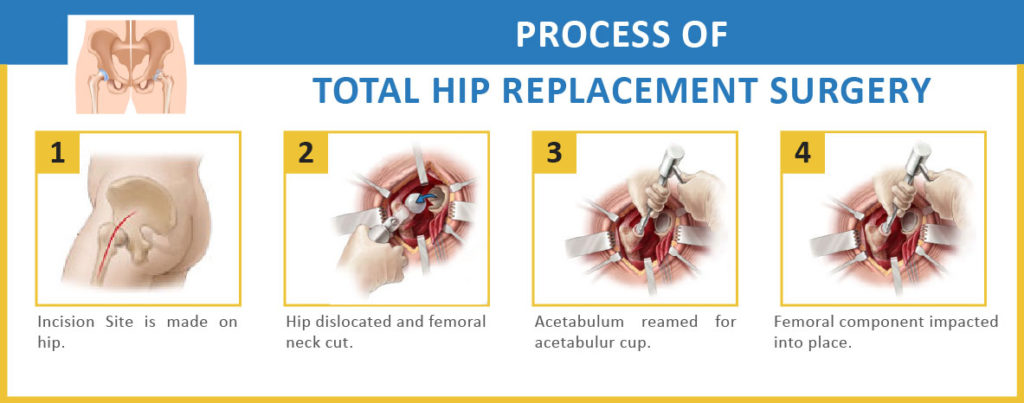Asan Medical Centre
Seoul,South Korea

Everybody knows about or has heard of total hip replacement. However, there are many people who have no idea what hip resurfacing surgery is and how it can possibly be used as a replacement for the total hip replacement.
However, that does not mean that every individual who has been recommended a total hip replacement can opt for this alternative. Hip resurfacing is a less invasive form of joint replacement surgery, which is advised to only selected individuals.
This article talks about some of the major differences between hip resurfacing and total hip replacement. Additionally, it also explores some of the possible advantages and disadvantages of hip resurfacing over hip replacement.

Both hip resurfacing and hip replacement intend to relieve pain arising out of the degenerative changes in the hip joint. Both of these can be advised to patients with osteoarthritis of the hip joint. The difference lies in the approach used to conduct the surgery and the procedure followed.
In conventional hip replacement surgery, the entire socket and the ball part of the hip joint are replaced with artificial implants. The implants could be either metal or ceramic implants or a combination of both.
The ball is the top of the thigh bone called femur and it fits into the socket to form a joint. In total hip replacement surgery, the ball is completely removed and replaced with a prosthesis. The stemmed component of the implant is placed in the marrow cavity of the femur. The stemmed component has a ball at the top, which fits into the socket (also known as acetabulum). The entire ball-socket set-up then fits into the pelvis.

The set-up remains the same in the case of hip resurfacing as well, with a difference in the way how the thigh bone is addressed and treated. In hip resurfacing procedure, the ball on the top of the femur is not removed. Instead, it is shaved and to form a peg, which is then shaped or trimmed so that a metal ball can be placed around it. Therefore, the thigh bone is preserved in the case of hip resurfacing.
Seoul,South Korea
Asan Medical centre is the largest hospital in Korea attracting an increasing number of patients every year. Situated across an area of 574,700 m2 the hospital has 2700+ beds attracting 11,862 outpatients and 2557 in-patients on an average per day.
The hospital is one of the preferred centres for critical procedures like cardiac, organ transplants, Cancer, Endocrinology, Nephrology, Neurology etc. It boasts of state-of-the-art medical facilities comparable to that of advances hospita... Read More
104
PROCEDURES
40
DOCTORS in 12 Specialties
5+
Facilities & Amenities
Tel Aviv,Israel
Tel Aviv Medical Center is one of the leading multi-disciplinary hospitals in Israel. The hospital with its modern infrastructure, cutting-edge technologies offering world-class healthcare standards is one of the premier hospitals and a preferred destination for medical tourists coming to Israel from all over the world.
Spanning an area of around 52 acres, the hospital comprises of 60 departments across its 5 institutions.
Statistics report that ... Read More
93
PROCEDURES
26
DOCTORS in 10 Specialties
6+
Facilities & Amenities
Delhi,India
2 Reviews
Max Smart is a 250 bedded multi-speciality tertiary care hospital owned and operated by the Max Healthcare Group. Offers services across multiple specialities like Cardiac, Orthopedics, Urology, Neurology, Pediatrics, Obstetrics and Gynecology.
Facilities:-
Comfortable rooms in all categories ranging from presidential suite, economy, d... Read More
112
PROCEDURES
24
DOCTORS in 12 Specialties
20+
Facilities & Amenities
2+
Reviews
Abu Dhabi,United Arab Emirates
Located in Abu Dhabi, Lifecare Hospital is the unit of VPS Healthcare. It endeavours to offer cost-effective yet premium healthcare services to serve the growing needs of the massive population of the emirates of Abu Dhabi. Lifecare Hospital continues to keep pace with the latest developments in healthcare delivery systems and follows the best practices to improve their service delivery standards. Lifecare Hospital offers its patients the facilities of critical care services (ICU, NICU), phy... Read More
52
PROCEDURES
17
DOCTORS in 9 Specialties
6+
Facilities & Amenities
Istanbul,Turkey
Kadikoy Hospital has 35 years of experience in offering services in the medical field at a high level. The hospital is dedicated to the patients’ satisfaction, which is attained by the use of advanced technology, the use of new methods and traditional service quality.
In order to fulfil the increasing demand of patients, Acibadem Kadıköy Hospital was renovated in 1998, growing the area of enclosed section three-fold from 5000 m² to 17.600 m². In 2008, all inpati... Read More
94
PROCEDURES
28
DOCTORS in 10 Specialties
6+
Facilities & Amenities
Fethiye,Turkey
When it comes to medical services, people nowadays do not compromise with the treatment at all. There are people who are going on health tours just to cure their health complication by the best doctors available out there. The health industry all around the world has been changing, so many hospital and clinics are opening up to serve people and the competition is rapidly increasing alongside in this industry as well.
Lokman Hekim Esnaf Hospital in Turkey is one of the oldest members ... Read More
48
PROCEDURES
10
DOCTORS in 9 Specialties
6+
Facilities & Amenities
Pros:
Cons:
Ease of Revision Surgery:
A revision surgery is easier and more successful in case it is conducted after hip resurfacing than hip replacement. This is because in the former case, the thigh bone is preserved and less bone is removed. Whereas in the case of hip replacement, the ball portion of the femur is completely removed and replaced with an implant. This results in a considerable bone loss, which makes revision surgery a tedious task to perform. There is not much bone left to fix another implant.
Thigh Bone Fracture
Because the individuals’ natural femoral head is retained during the hip resurfacing surgery, there are high chances of thigh-bone fracture. However, this is not the case with hip replacement. If a thigh-bone fracture occurs during hip resurfacing, the surgeons have no option but to continue with the total hip replacement procedure. But that does not mean that fractures cannot happen at all in the case of hip replacement. It can still occur around any of the implanted components.
Incision Size
Hip resurfacing is a bigger and more complicated procedure than hip replacement even though it results in less bone loss. This is because it requires manipulation of the femoral head to the placement of the metallic ball. This may require a bugger incision than hip replacement. Because it is more difficult and risky, many surgeons do not perform hip resurfacing.
Implant Type
For total hip replacement, there a wide variety of implants available. This includes metallic, polyethylene, and ceramic implants. However, hip resurfacing is only conducted with the help of metallic implants. Implant manufacturers around the world are currently working on ceramic implants for hip resurfacing.
Longevity
Hip resurfacing lasts longer than a hip replacement for most of the patients. This procedure is particularly beneficial for young individuals. This is because in their case, they are expected to outlive the normal lifespan of the implants used in the case of total hip replacement.
Return to Normal Routine
People who undergo hip resurfacing are more likely to return to their normal routine and activities such as running, skiing, and other competitive sports. However, this is not true about people who undergo total hip replacement. Overall, people who undergo hip resurfacing live a more active and functional life than those who undergo total hip arthroplasty.
Risk of Dislocation and Inaccurate Leg Length
Because of the larger size of the ball in the case of hip resurfacing, there is a reduced risk of dislocation. A dislocation is characterized by the disengagement of the ball from the socket. Om the other hand, the risk of inaccurate leg length is more in total hip arthroplasty. Hip resurfacing ensures an equal length of both the legs because the natural bone (femur) is preserved in the patients.
Best Candidates For Hip Resurfacing Procedure
Not everyone is suitable for hip resurfacing procedure. For example, men are more likely to have a successful procedure than women. Also, people with osteoarthritis of the knee do better with hip resurfacing than those who have avascular necrosis.
Hip resurfacing is considered the best for younger men who live an active lifestyle and have average height. It has many benefits to offer as compared to total hip replacement. It can make people return to their normal and active lifestyle. However, only a surgeon is able to tell whether a hip resurfacing or total hip arthroplasty is what you need.

With over 14 years of experience. Dr. Vijita Jayan is an extremely competent, skilled & revered Senior Neuro Physiotherapist. She holds an impeccable academic record and extensive experience in the field of neuro-rehabilitation. She is renowned for handling mobility-dependent cases. She is also an avid writer of several published articles & research papers. Being awarded several accolades in her career, she is considered one of the leading names In the field of Physical Medicine and Rehabilitation.
(+1) 424 283 4838